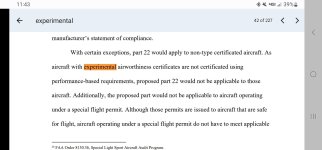Mods, I hope this is OK to post but please don't ban me if not!
The FAA has released the draft NPRM for MOSAIC. I took a quick skim through the document. Interestingly, it looks like all RVs would qualify as light sport aircraft. The main thing is that they're eliminating the specific weight limit although it remains implied with a 54kcas stall speed of, "around 3000 pounds." Also, the top speed is 250kcas, night and IMC are OK, as are retracts.
Four seats are OK but a sport pilot can only fly with one passenger. Interestingly, they specifically addressed a private pilot operating one of these new light sport aircraft with four seats and they can fill the seats.
If MOSAIC finally comes to fruition, we might see completed RVs rolling off the line for sale. Or even kits with more than 51% complete. What a time to be alive.
EDIT: I'm wrong about all of the RV's being applicable. The stall speed requirement is in a clean configuration (Vs1).
The FAA has released the draft NPRM for MOSAIC. I took a quick skim through the document. Interestingly, it looks like all RVs would qualify as light sport aircraft. The main thing is that they're eliminating the specific weight limit although it remains implied with a 54kcas stall speed of, "around 3000 pounds." Also, the top speed is 250kcas, night and IMC are OK, as are retracts.
Four seats are OK but a sport pilot can only fly with one passenger. Interestingly, they specifically addressed a private pilot operating one of these new light sport aircraft with four seats and they can fill the seats.
If MOSAIC finally comes to fruition, we might see completed RVs rolling off the line for sale. Or even kits with more than 51% complete. What a time to be alive.
EDIT: I'm wrong about all of the RV's being applicable. The stall speed requirement is in a clean configuration (Vs1).
Last edited:






